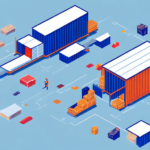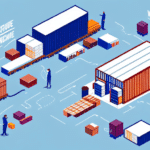6 Strategies to Optimize Reverse Logistics
In today’s competitive business landscape, companies are striving to offer exceptional customer experiences, which include smooth and hassle-free returns processes. Reverse logistics play a crucial role in this effort by enabling businesses to efficiently handle customer returns, manage product recalls, reuse or recycle products, and reduce waste. Optimizing reverse logistics operations can, however, be challenging. In this article, we discuss six strategies that businesses can adopt to maximize the returns on their reverse logistics programs.
1. Understanding Reverse Logistics and Its Importance
Reverse logistics refers to the process of managing product returns, recycling, and disposal. It is a critical component of successful supply chain management, helping companies reduce operational costs, optimize inventory levels, and improve customer experience. Effective reverse logistics management can help businesses retain customers by providing a smooth and hassle-free returns process.
One of the key benefits of reverse logistics is its positive impact on the environment. By properly disposing of products and recycling materials, companies can reduce their carbon footprint and contribute to a more sustainable future. According to the 2023 EPA Sustainability Report, businesses that implement robust reverse logistics practices can decrease their waste by up to 30%.
Another important aspect of reverse logistics is its role in managing excess inventory. By effectively handling returns and recycling, companies can reduce the amount of excess inventory they hold, leading to significant cost savings. This is particularly important in industries where products have a short shelf life or where demand is highly variable.
2. Leveraging Technology to Optimize Reverse Logistics
The use of technology can greatly aid in optimizing reverse logistics operations. Advanced software and data analytics tools help companies track their inventory, forecast demand, and anticipate returns. Technologies such as RFID and barcodes enable companies to track goods throughout the supply chain and identify the root causes of returns. According to a 2023 McKinsey Industry Report, businesses that leverage these technologies can reduce return processing times by up to 25%.
Automation is another critical technology in reverse logistics. Automated systems can streamline the returns process, reducing the time and effort required to process returns. This leads to faster refunds or exchanges for customers, enhancing their overall experience. Additionally, automation reduces the risk of errors in the returns process, ensuring that returned products are properly handled and disposed of.
Moreover, technology supports sustainability efforts within reverse logistics. By tracking the environmental impact of returned products, companies can identify areas for improvement and implement more sustainable practices. For example, companies may choose to refurbish and resell returned products instead of disposing of them, reducing waste and extending product lifespans. This not only benefits the environment but also results in cost savings for the company.
3. Overcoming Challenges in Reverse Logistics Management
Managing reverse logistics operations can be challenging due to factors such as product quality issues, damage during transit, incorrect shipments, and returns driven by customer preferences. Additionally, managing inventory levels and determining the optimal disposal method for returned products add to the complexity. To address these challenges, businesses must regularly assess their returns processes, identify inefficiencies, and implement corrective actions.
Another significant challenge is the increasing pressure to reduce the environmental impact of returned products. Many businesses are implementing sustainable practices in their reverse logistics operations, such as recycling, refurbishing, or reselling returned products. However, these practices can be costly and require significant investments in technology and infrastructure. Businesses must weigh the costs and benefits of these sustainable practices to determine the most effective approach for their operations.
4. Implementing a Successful Reverse Logistics Program
To implement a successful reverse logistics program, businesses must establish clear policies and procedures for managing returns. These policies should be clearly communicated to customers, and employees must be trained in their implementation. Additionally, businesses need a clear understanding of their inventory levels and must ensure that they have adequate storage and disposal facilities.
Partnering with logistics service providers who specialize in reverse logistics can also be beneficial. These partners bring expertise in managing returns operations efficiently, allowing businesses to focus on their core competencies.
Tracking and analyzing data related to returns is another crucial aspect of a successful reverse logistics program. This data provides valuable insights into the reasons for returns, identifies which products are returned most frequently, and calculates the cost of managing returns. By analyzing this data, businesses can identify areas for improvement and make informed decisions to optimize their reverse logistics processes.
5. Streamlining the Returns Process for E-commerce Businesses
E-commerce businesses must focus on streamlining their returns processes to ensure customer satisfaction. This can be achieved by providing customers with a clear and simple returns process, offering multiple return options, and ensuring process transparency. Adequate inventory levels are essential so that customers receive replacement products promptly. Integrating return data with inventory management systems helps businesses manage product returns efficiently.
Providing customers with timely updates on the status of their returns through automated email notifications or an online portal improves customer satisfaction and reduces inquiries related to returns.
Offering incentives to customers who choose to exchange their products instead of returning them can also be effective. Incentives such as discounts on future purchases or free shipping on the next order encourage exchanges, reducing the number of returns and enhancing customer loyalty.
6. Embracing Sustainable Practices in Reverse Logistics
Adopting sustainable strategies helps businesses reduce waste and contribute to environmental conservation. Strategies include:
- Recycling Programs: Implementing programs to recycle returned products and materials.
- Donating Returned Products: Donating usable returned products to charities.
- Collaborating with Sustainable Logistics Providers: Partnering with logistics providers who prioritize sustainability.
- Improving Product Quality: Enhancing product quality to minimize returns.
- Educating Customers: Promoting responsible consumption and disposal among customers.
These practices not only benefit the environment but also enhance the company’s reputation and can lead to cost savings in the long run.
Measuring Success: Key Metrics for Evaluating Your Reverse Logistics Program
Measuring the success of your reverse logistics program is critical for identifying areas of improvement. Key metrics include:
- Cost per Return: The total cost associated with processing a return.
- Time to Process Returns: The time taken from the initiation of a return to its completion.
- Customer Satisfaction Rates: Customer feedback and satisfaction related to the returns process.
- Resale or Repurposing Rate: The percentage of returned products that are resold or repurposed.
These metrics help businesses quantify the impact of their reverse logistics programs, benchmark performance against competitors, and track progress over time.
Collaborating with Partners to Enhance Reverse Logistics Operations
Collaboration with partners such as distributors, suppliers, and logistics service providers can significantly improve reverse logistics operations. By working together, businesses can identify inefficiencies in their supply chains, optimize inventory levels, and reduce turnaround times.
Collaboration also leads to a better understanding of customer needs and preferences, enabling businesses to offer tailored solutions that enhance customer satisfaction.
Leveraging Data Analytics to Enhance Your Reverse Logistics Program
Data analytics provides businesses with valuable insights into their reverse logistics operations. By analyzing return data, businesses can identify patterns and trends in product returns, enabling them to take corrective actions to prevent future returns.
Data analytics also helps businesses optimize inventory levels, reduce waste, and improve the overall efficiency of their reverse logistics programs. Implementing advanced analytics tools can lead to more informed decision-making and better strategic planning.
Future Trends in Reverse Logistics
The future of reverse logistics is promising, with numerous opportunities for businesses to enhance their operations. Key predictions include:
- Increased Focus on Sustainability: Businesses will prioritize eco-friendly practices such as recycling and refurbishing returned products.
- Advanced Technologies: The adoption of IoT and big data will enable businesses to optimize reverse logistics programs and improve customer satisfaction.
- Industry Collaboration: Greater collaboration among companies will lead to shared resources and expertise, enhancing efficiency and reducing costs.
- Enhanced Customer Experience: Businesses will continue to innovate to provide exceptional customer experiences through seamless and efficient returns processes.
Staying abreast of these trends and embracing new technologies and practices will allow businesses to remain competitive and offer exceptional customer experiences.
Conclusion
Optimizing reverse logistics operations is a challenging but essential task for businesses aiming to maximize their returns on reverse logistics programs. By establishing clear policies and procedures, leveraging technology, collaborating with partners, and adopting sustainable practices, businesses can create a seamless and hassle-free returns process that not only enhances customer satisfaction but also contributes to cost savings and environmental sustainability.




















